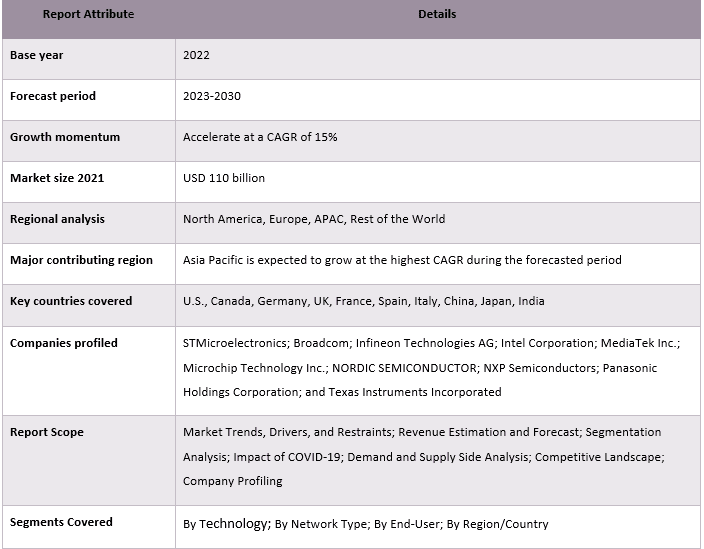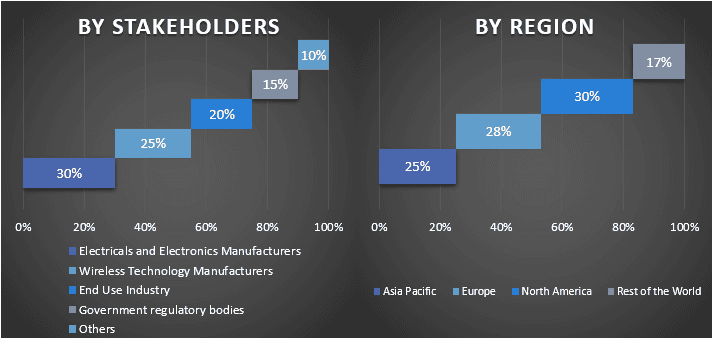- Home
- About Us
- Industry
- Services
- Reading
- Contact Us
Wireless Connectivity Technology Market: Current Analysis and Forecast (2022-2030)
Emphasis on Technology (Bluetooth, Wi-Fi, Ultra-Wideband, NFC, Cellular, Zigbee, GPS, and Others), Network Type (Wireless Wide Area Network (WWAN), Wireless Personal Area Network (WPAN), and Wireless Local Area Network (WLAN)), End-User (Automotive And Transportation, Consumer Electronics And Wearables, Healthcare, Industrial, IT And Telecom, and Others), Region/Country.

The wireless connectivity technology market is valued at USD 110 Billion in 2022 & is expected to grow at a CAGR of 15% from 2023-2030. Wireless connectivity technology refers to the set of technologies and protocols that enable data transmission and communication between devices without the need for physical wires or cables. It facilitates seamless and real-time exchange of information over the air, allowing devices to communicate, share data, and access the internet wirelessly. This technology has become a vital enabler of modern life, providing mobility, real-time communication, internet accessibility, and numerous benefits in day-to-day activities, enhancing productivity, convenience, and overall quality of life for individuals and businesses alike, which finds its applications in almost all industries. Wireless connectivity technology is getting used in numerous ways in today’s time which includes, internet access where Wi-Fi and mobile data networks enable wireless internet access, allowing users to connect their devices to the internet without using wired connections. Furthermore, wireless connectivity plays a pivotal role in connecting Internet of Things (IoT) devices, enabling them to share data and communicate with each other and central servers. Moreover, devices like smartwatches and fitness trackers which are high in demand and almost everyone wants one for them, use wireless connectivity (e.g., Bluetooth) to sync data with smartphones and access various services. In addition to this, wireless technology facilitates communication between sensors, controllers, and machines, enabling efficient industrial automation processes. Additionally, wireless technologies have taken a large space in every aspect of humans or a product lifecycle, and are an enabler of things like information access, smart home control, industrial automation, navigation, health, and fitness, etc. and are becoming a part of every industry and almost every electrical product that is getting launched today. For instance, in February 2023, at Mobile World Congress held in Barcelona, Cisco and T-Mobile announced plans to offer businesses Cisco Meraki’s first-ever 5G cellular gateways for fixed wireless access (FWA), the MG51 and MG51E. Overall, convenience, mobility, IoT integration, digital transformation, wearable devices, location-based services, interoperability, energy efficiency, safety, security, cost-effectiveness, and consumer expectations have all contributed to the increased usage and rising demand for wireless connectivity technology globally.
Some of the major players operating in the market include STMicroelectronics; Broadcom; Infineon Technologies AG; Intel Corporation; MediaTek Inc.; Microchip Technology Inc.; NORDIC SEMICONDUCTOR; NXP Semiconductors; Panasonic Holdings Corporation; and Texas Instruments Incorporated
Insights Presented in the Report
“Amongst technology, the Bluetooth, Wi-Fi, and GPS wireless connectivity technology holds the major segment and is also anticipated to witness a significant CAGR growth during the forecast period.”
Based on technology, the market is segmented into Bluetooth, wi-fi, ultra-wideband, NFC, cellular, ZigBee, GPS, and others. The most used wireless connectivity technologies are Bluetooth, wi-fi, and GPS which have become a mass-market product and hold the majority share of the market. The primary factors responsible for this domination over other product offerings are Wi-Fi, GPS, and Bluetooth provide seamless wireless connectivity, enabling users to stay connected and access data on the go. This convenience and mobility have made them essential for smartphones, tablets, laptops, and other portable devices. Furthermore, Wi-Fi has become the primary means for accessing the Internet in homes, offices, and public spaces. The capability of Wi-Fi for high-speed data transfer has led to its widespread adoption for internet connectivity. In addition to this, the Internet of Things (IoT) has seen rapid growth, and Wi-Fi, GPS, and Bluetooth play crucial roles in connecting and communicating with various IoT devices, making them essential for smart homes, wearables, industrial automation, and smart cities.
“Amongst network types, the WWAN (wireless wide area network) holds the significant share of the market as of 2022.”
Based on the network type, the market is segmented into a wireless wide area network (WWAN), wireless personal area network (WPAN), and wireless local area network (WLAN). Among all the other network types WWAN has been adopted widely and holds a major share of the market. The notable factors attributed to the popularity of WWAN networks are their capability to provide extended coverage over large geographic areas, making them suitable for connecting devices and users over long distances. Furthermore, WWAN offers mobility and flexibility as it allows devices to maintain connectivity while moving within the coverage area. This makes it suitable for applications like mobile Internet access, vehicle telematics, and IoT deployments. In addition to this, WWAN operates on cellular networks, which are well-established and reliable in most regions. This integration ensures consistent and widespread connectivity, even in areas with limited WLAN or WPAN coverage.
“Asia Pacific is anticipated to be the fastest growing wireless connectivity technology market during the forecasted period.”
Asia Pacific is the fastest-growing market for wireless connectivity technology due to several factors that have contributed to the increasing adoption and demand in the region such as rapid urbanization, leading to an increased demand for wireless connectivity in urban areas to support the growing population and their connected devices. Furthermore, many countries in the Asia Pacific have a mobile-first population, where mobile devices are the primary means of accessing the internet. This has created a surge in demand for mobile data and wireless connectivity. In addition to this, the region has experienced significant growth in internet penetration, with more people gaining access to the internet through smartphones and other devices, fueling the demand for wireless connectivity. For instance, as of 2022, China has more than a billion internet users, higher than anywhere else in the world. Followed by China, India ranked two in the internet users base where almost 933 million Indians have access to the internet via any device. Moreover, rising e-commerce and digital services in the region are further boosting the demand for wireless connectivity technology, where the popularity of e-commerce platforms and digital services in the region has led to increased demand for wireless connectivity to support online transactions, streaming, and other digital activities. Additionally, the adoption of mobile payments and financial technology (FinTech) solutions has surged in Asia Pacific, creating a need for secure and reliable wireless connectivity for transactions and financial services. Overall, the combination of the factors listed above has propelled Asia Pacific to become the fastest-growing market for wireless connectivity technology with a continuous increase in adoption and demand.
Wireless Connectivity Technology Market Report Coverage

Reasons to buy this report:
- The study includes market sizing and forecasting analysis validated by authenticated key industry experts.
- The report presents a quick review of overall industry performance at one glance.
- The report covers an in-depth analysis of prominent industry peers with a primary focus on key business financials, product portfolios, expansion strategies, and recent developments.
- Detailed examination of drivers, restraints, key trends, and opportunities prevailing in the industry.
- The study comprehensively covers the market across different segments.
- Deep dive regional level analysis of the industry.
Customization Options:
The global wireless connectivity technology market can further be customized as per the requirement or any other market segment. Besides this, UMI understands that you may have your own business needs, hence feel free to connect with us to get a report that completely suits your requirements.
Table of Content
Research Methodology for the Wireless Connectivity Technology Market Analysis (2023-2030)
Analyzing the historical market, estimating the current market, and forecasting the future market of the global wireless connectivity technology market were the three major steps undertaken to create and analyze the adoption of wireless connectivity technology in major regions globally. Exhaustive secondary research was conducted to collect the historical market numbers and estimate the current market size. Secondly, to validate these insights, numerous findings and assumptions were taken into consideration. Moreover, exhaustive primary interviews were also conducted, with industry experts across the value chain of the global wireless connectivity technology market. Post assumption and validation of market numbers through primary interviews, we employed a top-down/bottom-up approach to forecasting the complete market size. Thereafter, market breakdown and data triangulation methods were adopted to estimate and analyze the market size of segments and sub-segments of the industry pertains to. Detailed methodology is explained below:
Analysis of Historical Market Size
Step 1: In-Depth Study of Secondary Sources:
Detail secondary study was conducted to obtain the historical market size of the wireless connectivity technology market through company internal sources such as annual reports & financial statements, performance presentations, press releases, etc., and external sources including journals, news & articles, government publications, competitor publications, sector reports, third-party database, and other credible publications.
Step 2: Market Segmentation:
After obtaining the historical market size of the wireless connectivity technology market, we conducted a detailed secondary analysis to gather historical market insights and share for different segments & sub-segments for major regions. Major segments are included in the report as technology, network type, and end-user. Further country-level analyses were conducted to evaluate the overall adoption of testing models in that region.
Step 3: Factor Analysis:
After acquiring the historical market size of different segments and sub-segments, we conducted a detailed factor analysis to estimate the current market size of the wireless connectivity technology market. Further, we conducted factor analysis using dependent and independent variables such as technology, network type, and end-user of the wireless connectivity technology market. A thorough analysis was conducted for demand and supply-side scenarios considering top partnerships, mergers and acquisitions, business expansion, and product launches in the wireless connectivity technology market sector across the globe.
Current Market Size Estimate & Forecast
Current Market Sizing: Based on actionable insights from the above 3 steps, we arrived at the current market size, key players in the global wireless connectivity technology market, and market shares of the segments. All the required percentage shares split and market breakdowns were determined using the above-mentioned secondary approach and were verified through primary interviews.
Estimation & Forecasting: For market estimation and forecast, weights were assigned to different factors including drivers & trends, restraints, and opportunities available for the stakeholders. After analyzing these factors, relevant forecasting techniques i.e., the top-down/bottom-up approach were applied to arrive at the market forecast for 2030 for different segments and sub-segments across the major markets globally. The research methodology adopted to estimate the market size encompasses:
- The industry’s market size, in terms of revenue (USD) and the adoption rate of the wireless connectivity technology market across the major markets domestically
- All percentage shares, splits, and breakdowns of market segments and sub-segments
- Key players in the global wireless connectivity technology market in terms of products offered. Also, the growth strategies adopted by these players to compete in the fast-growing market
Market Size and Share Validation
Primary Research: In-depth interviews were conducted with the Key Opinion Leaders (KOLs) including Top Level Executives (CXO/VPs, Sales Head, Marketing Head, Operational Head, Regional Head, Country Head, etc.) across major regions. Primary research findings were then summarized, and statistical analysis was performed to prove the stated hypothesis. Inputs from primary research were consolidated with secondary findings, hence turning information into actionable insights.
Split of Primary Participants in Different Regions

Market Engineering
The data triangulation technique was employed to complete the overall market estimation and to arrive at precise statistical numbers for each segment and sub-segment of the global wireless connectivity technology market. data was split into several segments & sub-segments post studying various parameters and trends in the areas of propulsion, by drive, by application, and by purchasing option in the global wireless connectivity technology market.
The main objective of the Global wireless connectivity technology Market Study
The current & future market trends of the global wireless connectivity technology market were pinpointed in the study. Investors can gain strategic insights to base their discretion for investments on the qualitative and quantitative analysis performed in the study. Current and future market trends determined the overall attractiveness of the market at a regional level, providing a platform for the industrial participant to exploit the untapped market to benefit from a first-mover advantage. Other quantitative goals of the studies include:
- Analyze the current and forecast market size of the wireless connectivity technology market in terms of value (USD). Also, analyze the current and forecast market size of different segments and sub-segments.
- Segments in the study include areas of technology, network type, and end-user.
- Define and analysis of the regulatory framework for the wireless connectivity technology
- Analyze the value chain involved with the presence of various intermediaries, along with analyzing customer and competitor behaviors of the industry.
- Analyze the current and forecast market size of the wireless connectivity technology market for the major region.
- Major countries of regions studied in the report include Asia Pacific, Europe, North America, and the Rest of the World
- Company profiles of the wireless connectivity technology market and the growth strategies adopted by the market players to sustain in the fast-growing market
- Deep dive regional level analysis of the industry
Related Reports
Customers who bought this item also bought










